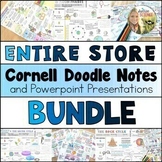DNA Structure Doodle Notes | Middle School Science | Cornell Notes
What educators are saying
Also included in
- This is a growing bundle of ALL of my Science Cornell Doodle Notes resources. This bundle currently contains Cornell Doodle Notes and the associated Powerpoint / Google Slides Presentations for 48 science topics. The price at this point reflects what is in the bundle at this time, plus 20% off. As aPrice $189.00Original Price $244.25Save $55.25
Description
These scaffolded Cornell Doodle Notes combine two effective note-taking strategies and can be used to introduce the structure of the DNA molecule, including the double helix shape, nucleotides, phosphate and sugar backbone, nitrogenous base pairing, hydrogen bonds, purines, and pyrimidines. Students receive the black and white version of the notes most appropriate for their level and complete the notes in a chunked sequence using the Powerpoint or Google Slides presentation. These notes offer lots of visuals and analogies to help students to understand the structure of the DNA molecule and how the genetic code is embedded in it.
These notes support NGSS MS-LS3: Heredity: Inheritance and Variation of Traits: Disciplinary Core Idea MS-LS3.A: Genes are located in the chromosomes of cells, with each chromosome pair containing two variants of each of many distinct genes. Each distinct gene chiefly controls the production of specific proteins, which in turn affects the traits of the individual; Crosscutting Concepts: Cause and Effect Relationships; Structure and Function.
Cornell Notes are a note-taking strategy in which topic questions are written in a narrow left-hand column and definitions, explanations, and diagrams are filled in in the right-hand column.
Doodle Notes (or Sketch Notes) are another note-taking strategy for which pictures and graphics activate the visual pathways of the brain, which helps with retention of information when compared to standard note-taking. Your visual learners will really benefit from seeing and coloring in the pictures aside the main points of the notes!
I created a Powerpoint that goes with these notes. The Powerpoint walks the students through the lesson from the Essential Question and through all of the Topic Questions. There is a “Sum It Up” section at the end of the notes, for which students practice applying the concepts.
The Cornell Doodle Notes are 3-pages and there are 3 scaffolded versions plus the answer key included.
The Powerpoint is included and there are also directions for accessing the presentation via Google Drive (Google Slides). This is obviously optional depending on how you choose to use this in your classroom.
Learn how to separate the differentiated versions of these notes in your Google Drive and how to assign them digitally using Google Classroom by downloading THIS FREEBIE!
Here are some ways that I suggest using this product:
✎ Whole-Group lesson with scaffolding : decide which students should receive which level of the notes. Hand out the notes to the students. Use the Powerpoint as a presentation and talk aloud through the lesson while the students take notes. Allow them to color/doodle further after each section and at the end of the lesson. {If you have a document camera (an ELMO), you can fill out your own notes and the students can follow along with you as you discuss the concepts aloud!}
✎ Scaffolded Small-Group lesson : separate your students into groups by learning level. Give each student group sets of the appropriate notes for their level. Make sure each group has a device to view the presentation. Post the Powerpoint or Google Slides to your Google Classroom or other online learning platform, or email the Powerpoint version to one ‘student leader’ in each group. The students would view the Powerpoint/Slides together on one device and fill in the notes. . Encourage them to add color/further notes.
✎ Individual Note-Taking or Flipped Classroom : Post the Powerpoint to your Google Classroom or other online learning platform or hand out the Google access directions to your students.. Hand out the appropriate-level notes to each student. Students can work at their own pace to view the presentation and complete their notes. Encourage them to add color/further notes.
Please note that this resource is not editable due to font and clip art licensing agreements.
Doodle notes is a trademarked term used with permission. Please visit doodlenotes.org for more information.
You may also be interested in these resources to round out your lessons on DNA Structure:
DNA Fingerprinting Simulated Crime Scene Activity
DNA Structure Inquiry Modeling Activity
DNA Structure and Replication 5E Lesson
Thanks for looking!
Sunrise Science






